Electoral history of Louis St. Laurent
This article is the Electoral history of Louis St. Laurent, the twelfth Prime Minister of Canada (1948-1957).

A Liberal, he served one term as Prime Minister (1948–1957), succeeding William Lyon Mackenzie King. He won two general elections (1948, 1953) and lost one (1957). John Diefenbaker succeeded him as prime minister, while Lester Pearson became the leader of the Liberal Party.
He stood for election to the House of Commons of Canada five times, all successfully.
Summary
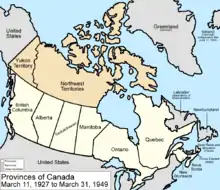
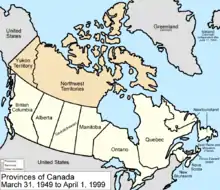
St. Laurent ranks ninth out of twenty-three prime ministers for time in office, serving one term of eight years and 218 days.[1]
St. Laurent was the third of eight prime ministers from Quebec, the others being Sir John Abbott, Sir Wilfrid Laurier, Pierre Trudeau, Brian Mulroney, Jean Chrétien, Paul Martin and Justin Trudeau. He was also the second of five francophone prime ministers, the others being Laurier, Pierre Trudeau, Chrétien, and Justin Trudeau.
A late-comer to politics, St. Laurent was a well-respected lawyer when Prime Minister Mackenzie King recruited him to the federal government, to replace Ernest Lapointe, King's long-time Quebec lieutenant, who had died suddenly.[2] St. Laurent served in King's government as Minister of Justice and Minister of External Affairs, as well as King's political Quebec lieutenant.[3] When King retired after his lengthy time in office, he supported St. Laurent for the leadership of the Liberal Party. St. Laurent won on the first ballot and automatically became prime minister.
St. Laurent led the Liberal Party in two general elections in 1949 and 1953, winning majority governments each time. However, in his third general election, the major issue was the building of a trans-Canada gas pipeline, with financing from the federal government. The financing proposal triggered a controversial debate in the House of Commons, which St. Laurent's government ended by the use of closure to push the measure through the Commons. St. Laurent and the Liberals were defeated in the general election of 1957, with John Diefenbaker forming a minority government. St. Laurent stayed on as Liberal leader and Leader of the Opposition for half a year after the election. He resigned as Liberal leader early in 1958 and retired from politics.[3] He was succeeded as Liberal leader by Lester B. Pearson.
St. Laurent stood for election to the Canadian House of Commons five times, all for the riding of Quebec East. He was elected each time (1942 (by-election), 1945, 1949, 1953 and 1957). He served in the Commons for a total of 16 years, 1 month, 20 days.[3]
Federal general elections, 1949 to 1957
St. Laurent led the Liberal Party in three general elections, winning two majority governments and losing once.
Federal election, 1949
St. Laurent won a decisive victory in the 1949 election. George Drew, the leader of the Progressive Conservative Party of Canada, continued as Leader of the Opposition.
| Party | Leaders | Seats Won | Popular Vote | |
|---|---|---|---|---|
| Liberal | Louis St. Laurent1 | 191 | 49.2% | |
| Progressive Conservative | George A. Drew2 | 41 | 29.7% | |
| Co-operative Commonwealth Federation | M. J. Coldwell | 13 | 13.4% | |
| Social Credit | Solon Earl Low | 10 | 2.3% | |
| Independent | – | 4 | 2.1% | |
| Independent Liberal | – | 1 | 0.5% | |
| Liberal-Labour | – | 1 | 0.2% | |
| Liberal–Progressive | – | 1 | 0.2% | |
| Total | 262 | 97.6%3 | ||
| Sources: Library of Parliament – History of Federal Ridings since 1867 | ||||
1 Prime Minister when election was called; Prime Minister after election.
2 Leader of the Opposition when election was called; Leader of the Opposition after the election.
3 Table does not include parties which received votes but did not elect any members.
Federal election, 1953
St. Laurent won a second victory in the 1953 election, though with a reduced majority. George Drew, the leader of the Progressive Conservative Party of Canada, continued as Leader of the Opposition.
| Party | Leaders | Seats Won | Popular Vote | |
|---|---|---|---|---|
| Liberal | Louis St. Laurent1 | 169 | 48.4% | |
| Progressive Conservative | George A. Drew2 | 51 | 31.0% | |
| Co-operative Commonwealth Federation | M. J. Coldwell | 23 | 11.3% | |
| Social Credit | Solon Earl Low | 15 | 5.4% | |
| Independent | – | 3 | 1.0% | |
| Independent Liberal | – | 2 | 1.2% | |
| Liberal–Progressive | – | 1 | 1.1% | |
| Liberal-Labour | – | 1 | 0.2% | |
| Total | 265 | 99.6%3 | ||
| Sources: Library of Parliament – History of Federal Ridings since 1867 | ||||
1 Prime Minister when election was called; Prime Minister after election.
2 Leader of the Opposition when election was called; Leader of the Opposition after the election.
3 Table does not include parties which received votes but did not elect any members.
Federal election, 1957
St. Laurent went to the polls a third time in 1957, but the election resulted in a hung parliament, with no party having a majority. Although the Liberals came in first in the popular vote, they came in second in seats in the House of Commons, behind John Diefenbaker and the Progressive Conservatives. St. Laurent resigned and Diefenbaker formed a minority government. St. Laurent became Leader of the Opposition, but resigned as Liberal leader in early 1958 and retired from politics.
| Party | Leaders | Seats Won | Popular Vote | |
|---|---|---|---|---|
| Progressive Conservative | John Diefenbaker1 | 112 | 38.5% | |
| Liberal | Louis St. Laurent2 | 105 | 40.5% | |
| Co-operative Commonwealth Federation | M. J. Coldwell | 25 | 10.6% | |
| Social Credit | Solon Earl Low | 19 | 6.5% | |
| Others | – | 4 | 1.0% | |
| Spoiled ballots | – | – | 1.1% | |
| Total | 265 | 98.2%3 | ||
| Sources: Library of Parliament – History of Federal Ridings since 1867 | ||||
1 Leader of the Opposition when election was called; Prime Minister after election.
2 Prime Minister when election was called; Leader of the Opposition after the election.
3 Table does not include parties which received votes but did not elect any members.
Federal constituency elections, 1942 to 1957
1942 Federal By-Election: Quebec East
The 1942 by-election was triggered by the death of Ernest Lapointe, the incumbent Member of Parliament on November 26, 1941. Lapointe had been King's Quebec lieutenant. King encouraged St. Laurent to stand for election in the vacant riding of Quebec East, and also take over Lapointe's political role.
| Party | Candidate | Popular Vote | % | |
|---|---|---|---|---|
| Liberal | 16,708 | 56.7% | ||
| Parti canadien | Paul Bouchard | 12,768 | 43.3% | |
| Total | 29,476 | 100.0% | ||
| Source: Library of Parliament – History of Federal Ridings since 1867: Quebec East | ||||
![]() Elected.
Elected.
1945 Federal Election: Quebec East
| Party | Candidate | Popular Vote | % | |
|---|---|---|---|---|
| Liberal | 25,832 | 59.8% | ||
| Independent | Noël Dorion | 7,197 | 23.9% | |
| Social Credit | Gérard Mercier | 2,816 | 9.4% | |
| Bloc popular canadien | Joseph-Norbert-Jules Therein | 1,463 | 4.9% | |
| Independent | Paul-Émile Latouche | 280 | 0.9% | |
| Co-operative Commonwealth Federation | François-Xavier Perron | 231 | 0.8% | |
| Labor-Progressive Party | Joseph-Gaudias De Croiselles | 109 | 0.4% | |
| Total | 30,061 | 100.1%1 | ||
| Source: Library of Parliament – History of Federal Ridings since 1867: Quebec East | ||||
![]() Elected.
Elected.
X Incumbent.
1 Rounding error.
1949 Federal Election: Quebec East
| Party | Candidate | Popular Vote | % | |
|---|---|---|---|---|
| Liberal | 25,832 | 73.6% | ||
| Progressive Conservative | Mark Robert Drouin | 7,876 | 22.4% | |
| Union des électeurs | Alphonse Tousignant | 1,395 | 4.0% | |
| Total | 35,103 | 100.0% | ||
| Source: Library of Parliament – History of Federal Ridings since 1867: Quebec East | ||||
![]() Elected.
Elected.
X Incumbent.
1953 Federal Election: Quebec East
| Party | Candidate | Popular Vote | % | |
|---|---|---|---|---|
| Liberal | 25,945 | 78.7% | ||
| Progressive Conservative | Raymond Maher | 5,841 | 17.7% | |
| Labor-Progressive Party | Gérard Fortin | 438 | 1.3% | |
| Locataire | Louis Seigneur | 417 | 1.3% | |
| Anti-Communst | Patrick Walsh | 333 | 1.0% | |
| Total | 32,974 | 100.0% | ||
| Source: Library of Parliament – History of Federal Ridings since 1867: Quebec East | ||||
![]() Elected.
Elected.
X Incumbent.
1957 Federal Election: Quebec East
| Party | Candidate | Popular Vote | % | |
|---|---|---|---|---|
| Liberal | 27,364 | 72.0% | ||
| Progressive Conservative | Louis Gagnon | 9,900 | 26.1% | |
| Social Credit | Roland Roy | 739 | 1.9% | |
| Total | 38,003 | 100.0% | ||
| Source: Library of Parliament – History of Federal Ridings since 1867: Quebec East | ||||
![]() Elected.
Elected.
X Incumbent.
Liberal Party leadership convention, 1948
St. Laurent entered the convention as the favourite, with King's support in opposition to James Gardiner, the long-time Minister of Agriculture from Saskatchewan. St. Laurent won on the first ballot, after most other nominees dropped out as a result of King's manoeuvering behind the scenes.
| Candidate | First Ballot | ||||||||||
|---|---|---|---|---|---|---|---|---|---|---|---|
| Votes cast | % | ||||||||||
 |
Louis St. Laurent | 848 | 69.1% | ||||||||
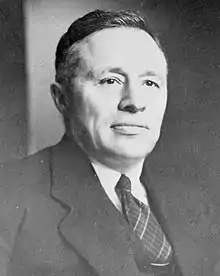 |
James Garfield Gardiner | 323 | 26.3% | ||||||||
 |
Charles Gavan Power | 56 | 4.6% | ||||||||
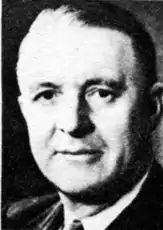 |
Douglas Abbott* | – | – | ||||||||
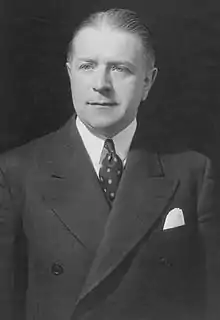 |
Lionel Chevrier* | – | – | ||||||||
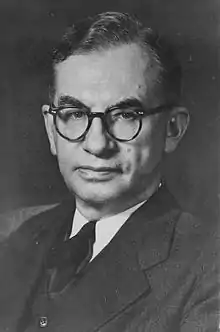 |
Brooke Claxton* | – | – | ||||||||
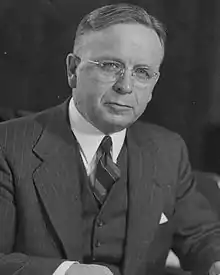 |
Stuart Garson* | – | – | ||||||||
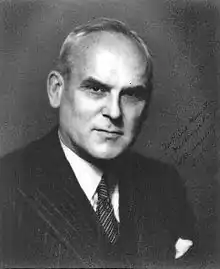 |
C.D. Howe* | – | – | ||||||||
| Paul Martin Sr.* | – | – | |||||||||
| Total | 1,227 | 100.0% | |||||||||
| Source: CPAC – 1948 Liberal Convention | |||||||||||
- Nominated, but withdrew on the floor of the convention prior to the first ballot.
See also
- Electoral history of William Lyon Mackenzie King - St. Laurent's predecessor as leader of the Liberal Party and as Prime Minister.
- Electoral history of John Diefenbaker - St. Laurent's successor as Prime Minister.
- Electoral history of Lester B. Pearson - St. Laurent's successor as leader of the Liberal Party.